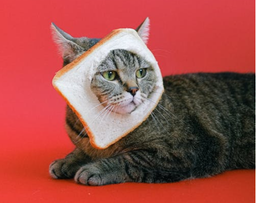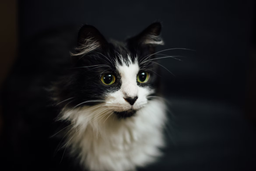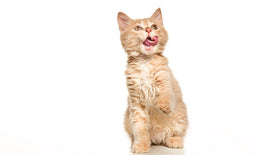Can cats eat mushrooms, or will it get them in truffle?
While the exclusively carnivorous felines hardly ever nibble on plants, there’s a certain substance called glutamate in mushrooms that cats find appetising. But are fungi a food fit for felines? Since some mushrooms contain toxins, cat parents are apprehensive about including them in their pet’s meal plan, even as treats. So, can cats eat mushrooms, or do the risks outweigh the gains? Let’s find out!
Why do cats eat mushrooms?
Unlike humans or dogs, cats aren’t omnivorous, and their taste buds are limited to certain flavours. Because they’re evolutionarily conditioned to feast on meat, felines respond more strongly to savoury than sweet tastes.
Mushrooms are rich in glutamate, an amino acid that provides a distinct umami taste that entices felines. Your cat’s keen sense of smell can detect the delicious substance and become drawn to it.
Can cats eat mushrooms?

If you live near a wooded area, watch out for your pet! Wild mushrooms can be extremely poisonous to both humans and cats. Only experienced pickers can recognise which ones are safe for eating.
Source: Presetbase Lightroom Presets
Whether cats can eat mushrooms depends on the variety. Commercially sold mushrooms that are safe for humans are also fit for cats. You can give them to your pet as a treat without any concerns.
Mushrooms are rich in amino acids, selenium, vitamin B, and antioxidants. Amino acids are essential nutrients in the feline diet responsible for their heart, brain, and eye function.
While some plants and fungi contain non-essential and essential amino acids, their bioavailability is limited. Animal protein is the only viable source of essential nutrients, like taurine and arginine, that sustain your cat’s metabolism, so it can’t be replaced with plant protein. Cats can eat commercially distributed mushrooms, but they won’t experience any real health benefits.
Wild mushrooms are an entirely different story. Since many of them contain toxic substances, the forest fungi are potentially life-threatening for both humans and felines.
If you let your cat roam outside, chances are they’ll come across a toxic wild mushroom. The seven deadliest mushrooms that can be found in our neck of the woods are:
- Deadly webcap or Cortinarius rubellus
- Angel's wings or Pleurocybella porrigens
- Death cap or Amanita phalloides
- Funeral bell or Galerina marginata
- Destroying angel or Amanita virosa
- Panther cap or Amanita pantherina
- Fool's funnel or Clitocybe rivulosa
Mushroom poisoning—symptoms and treatment
As the highly dramatic names suggest, wild mushrooms can be lethal to cats. The symptoms of food poisoning can manifest quickly, only a few hours after ingestion, depending on the variety. Your cat will most likely experience:
- Excessive salivation
- Vomiting and nausea
- Sensory issues
- Yellowing of the eyes and skin
If your cat has access to a wooded area and starts demonstrating these symptoms, take them to the emergency room immediately. The longer the toxins stay in your cat’s system, the more damage they’ll cause to their internal organs.
Your cat will be given a dose of activated charcoal to prevent further absorption of harmful substances. The vet may even induce vomiting upon arrival to remove the toxins from your pet’s stomach. In some cases, gastric lavage is required to flush the toxins from the digestive system.
Once your cat is stable, they’ll need plenty of rest and rehydration.

Where is the yummy smell coming from?
Source: Richard Burlton
How to serve mushrooms to cats safely
If your cat loses their whiskers every time you’re making creamy mushroom soup, consider giving them a taste. Any variety that you’d use in your kitchen is also safe for cats, including:
- White button mushroom
- Portobello mushroom
- Maitake mushroom
- Shiitake mushroom
- Cremini mushroom
- Hedgehog mushroom
- Enoki mushroom
- Oyster mushroom
The preparation method is different because cats have more sensitive stomachs. When preparing mushrooms for your feline companion, make sure you:
- Wash the mushrooms thoroughly
- Boil them in water without seasoning
- Wait for them to cool at room temperature
- Cut them into tiny, bite-sized pieces
The potential downside to feeding your cat mushrooms is that they may develop a preference for the fungi. If they’re an indoor-only pet, it won’t pose a problem, but if you allow them to go outside, they could end up eating a poisonous wild mushroom.
Should kittens eat mushrooms?

If you bought the mushrooms on the market and plan on using them for your pasta dinner—your kitty can have a bite!
Source: Andrew Ridley
Kittens require a delicate balance of fat, protein, and calcium to develop at a healthy rate. In the first three to four weeks, they get all the nutrients from their mother or, in her absence, from a specially formulated milk supplement (KMR).
When they start weaning, you can let them try mushrooms or other solid foods, but in limited amounts. Kitten food must be rich in essential nutrients to sustain their weight development and muscle growth while safeguarding their delicate tummies. Once they reach the 12-month mark, they can try different adult cat food products and endure more variety in their diet!
What should you feed your feline companion?
There’s much debate about what the best feline diet is or rather how to achieve the optimal nutritional balance. The recommended ratio of macronutrients is depicted in the table below:
|
Nutrient |
Recommended intake |
|
Protein |
More than 50% |
|
Fat |
Up to 20% |
|
Carbohydrates |
Less than 3% |
To achieve the desirable allowances of fat and protein, cat parents opt for one of the three popular feline meal plans:
- Raw food
- Dry food
- Wet food
Raw food
In the wild, felines would get the ideal protein-to-fat ratio by feasting on birds, rodents, or other freshly killed prey. Following the natural diet of felines, some cat parents believe that raw food is the only suitable replacement for domesticated cats.
The so-called “bones and raw food” diet (B.A.R.F.) looks good on paper, especially for cats struggling with obesity and diabetes, but in reality, it can be dangerous.
Raw meat and other raw ingredients, like uncooked eggs and unpasteurised milk, are the ideal breeding ground for several microbial pathogens. If your cat is exposed to raw food directly or through a contaminated surface, they can get infected with E. coli, Listeria, or Salmonella.
The signs of infection will manifest in the 12–72 hours after consumption in the form of:
- Fever
- Vomiting
- Diarrhoea
- Lethargy
- Appetite loss
Not only is the disease difficult on your cat, but it can potentially spread to the entire household. Additionally, no studies have shown that an entirely raw diet is superior to using processed foods in terms of nourishment. In some cases, it can even lead to nutritional imbalance since it’s difficult to maintain the ideal nutrient ratio in homemade raw meals. That’s why it’s better to rely on processed cat food carefully formulated to provide nourishment.
Dry cat food
Dry cat food is heavily processed and contains grain and other fillers that add to the calorie content. Some cats prefer the texture and aroma, but you should strive to correct that poor eating habit.
A dry-food-only diet lacks moisture which can result in chronic dehydration. Without water, felines can develop problems with digestion and urinary tract disease.
Dry biscuits and other high-calorie foods can contribute to the development of metabolic dysfunction. That’s why wet food is a healthier choice for your pet, especially if they have genetic predispositions for particular conditions. For example, Maine Coons are prone to diabetes malleus and should avoid kibble.
Wet cat food
High-quality moist cat food (and some semi-moist products) are filled with essential nutrients, such as:
- Water
- Animal protein
- Omega-3 and omega-6 fatty acids
- Natural vitamins and minerals
When compared to kibble or raw bones and meat, wet food is much more nourishing. But not all cats take a liking to it at first. Felines who haven’t been exposed to wet food during the weaning period can react poorly to the slimy texture. Luckily, it’s not too late to correct the behaviour! You can try the following tips:
- Soak your finger in the product and allow them to smell or lick it off
- Mix wet food with kibble or other ingredients they like
- Warm the meal in the microwave before serving
- Add soup or broth to the meal to enhance the aroma
- Clean their bowl thoroughly after each meal to prevent whisker fatigue
- Limit their access to food to stop them from picking at their meals
Running out of ideas to get your picky eater to eat wet food? Try Untamed! You can take our online quiz and design a custom menu your cat won’t be able to resist! We offer a wide range of gravy and jelly delicacies bound to make them come around. Check out our most popular products:
- Chocka Chicken in Jelly—Extra moist chicken breasts soaked in jelly and light on the tummy
- Tuck-in Tuna in Jelly—Cruelty-free tuna simmered in jelly and hearty fish broth
- Chocka Chicken with Duck in Jelly—The ultimate poultry platter, high-quality chicken breast mixed with whole duck meat, served in jelly
- Tuck-in Tuna with Salmon in Jelly—Delicious whole meat tuna soaked in jelly and served with high-grade salmon fillet

Untamed’s Tuck-in Tuna is 60% whole tuna meat and 100% fussy eater approved! Open a tin, and watch your picky pet go wild.
Image (c) Untamed
Untamed—your cat’s favourite meal
If you’re unsure what type of cat food to choose, Untamed is the perfect solution! Our tasty and nutritious meals are:
- High in protein—The protein content in a single serving of Untamed food is twice the industry standard. We don’t use plant protein, meat derivatives, or other useless or harmful substances, opting for the best animal protein for our feline delicacies instead
- Made with whole meat—We use premium meat cuts in our tasty and nourishing recipes. Each ingredient is of human-grade quality, and the final product is packed with bioavailable nutrients your cat needs to stay healthy
- Vet-formulated—Veterinarians designed our meals to meet your cat’s unique biological needs. Each serving is highly nutritional and free of all known allergens
- Ethically produced—When we say we care about creating a better world for our feline friends, we mean it! That’s why Untamed packaging is recyclable. We get our ingredients from sustainable sources and leave a neutral carbon footprint
- Impossible to resist—Untamed meals are as tasty as they are nourishing. Watch your fussy eater twist their whiskers in anticipation each time you open a tin of our gourmet cat food
Why go Untamed?

What’s in the box, mom? It smells yummy!
Image (c) Untamed
Untamed is dedicated to creating the perfect feline food that’ll provide nourishment but also bring joy to cats of all ages and breeds! Each step of the production process, from meal prep to packaging, is designed to benefit our feline friends—either directly, by using only human-grade meat cuts, or indirectly, by minimising our carbon pawprint and protecting the environment.
Our recipes are carefully designed to cater to your cat’s carnivorous nature. We centre all our recipes around delicious, nutrient-dense whole meats, such as:
- Chicken breast
- Duck breast
- Salmon fillet
- Tuna steak
- Sardine and mackerel fillet
You’ll be able to see the effect of our feline cuisine after the first serving! Besides being utterly irresistible, Untamed products can improve your pet’s quality of life significantly. Some long-term health benefits our customers noticed include:
|
Timeline |
Health benefits |
|
Within a week |
|
|
After two months |
|
|
Within four months |
|
|
Life-long benefits |
|
Want to join our clowder?
If you’re interested in becoming part of our community, all it takes is a few simple steps! Sign up for a trial cat food box and design a tailor-made meal plan for your feline companion. Here’s how to do it:
- Visit our Try Now page
- Tell us about your cat
- Choose a meal plan and confirm your order
We'll deliver your custom-made meal box within a day, with no additional shipping fees! If your cat takes to our food, you'll start receiving monthly supplies of Untamed products at the same time every month.
If you want to alter or cancel your order, feel free to reach out, and we’ll make adjustments to your cat food subscription as you desire.
What fruits and veggies are toxic to cats?
Besides wild mushrooms, some fruits and vegetables are also toxic to cats, such as:
- Grapes—Grapes and raisins can induce vomiting, diarrhoea, and restlessness in cats. If you regularly feed them to your feline, they’re at risk of developing kidney disease. We don’t know exactly what it is in grapes that causes such severe reactions in cats, but it’s present in both fresh and dried grapes and grape byproducts
- Citrus fruits—Cats aren’t particularly attracted to the intense smell of citric acid, but even tactile contact can cause skin irritations in more sensitive felines. If consumed regularly, these fruits can cause irreparable damage to your cat’s kidneys, as well as mild to severe indigestion. Minutes after eating an orange segment, felines can suffer from nausea, vomiting, and diarrhoea
- Allium vegetables—Plants from the allium family, especially garlic, onions, and chives, are y toxic to cats. These veggies are filled with thiosulphate, a substance that directly attacks the feline’s red blood cells. If you like treating your cat to a homemade meal from time to time, avoid these vegetables. Both fresh and powdered forms can cause anaemia and kidney disease
Does that mean all fruit is forbidden for felines? Certainly not! It’s okay to feed your cat some fruit and veggies in limited servings. High-fibre fruits, such as apples, bananas, pumpkins, and strawberries, can even help with indigestion or chronic bowel inflammations.
Even with the minor health benefits, fruits and vegetables are mostly useless to cats. All the micronutrients contained in plants (and fungi) are already present in meat. The better treat choice would be fish (tuna, salmon, prawns, sardines) or chicken (including liver).
Other food items your cat should avoid
Most of these foods and ingredients (except caffeine and alcohol) won’t cause immediate damage but are harmful in the long run. Cats must not eat the following items regularly (or at all in some instances):
- Dairy—Regardless of the age or breed, most cats lack the digestive enzyme required for processing lactose, so milk, cheese, and other dairy products are too much for them. Despite the natural intolerance, felines are drawn to fatty acids in milk and will try to get their paws on it. Don’t cave before the incessant meowing because dairy will give them severe indigestion. You can let them have a tiny bit of lactose-free milk or yoghurt but don’t encourage the habit
- Processed meat—Cured and processed meats contain high amounts of sodium and saturated fats. If you tend to share a charcuterie board with your pet, it may disrupt their metabolism after a while, especially if they’re older. Senior cats often develop hypertension and hyperthyroidism, and fatty meats will only speed up the process. Some cat food manufacturers use small amounts of ham in their products as a taste enhancer but other than that—avoid giving your cat meat derivatives
- Pork—Pork is the best option because of the high percentage of saturated fats (14 grams per 100 grams). Fish and chicken are much healthier alternatives since they have an equal allowance of animal protein and are less fatty
- Yeast and dough—The feline digestive tract can’t fully digest bread dough, and the residue can linger in their stomach for days, causing abdominal discomfort and constipation. In some cases, the remaining yeast can ferment in their stomach and produce alcohol. Ethanol is highly poisonous to cats, and even a tiny amount could put them in a coma
- Chocolate, coffee, and tea—Caffeine poisoning in cats manifests in muscle tremors, heavy breathing, heart palpitations, and extreme restlessness. In severe cases, it can even lead to seizures. To ensure your cat’s safety, try not to leave your cup of tea or java on the table without supervision—it’ll be too tempting for the more curious cat and potentially end with a rushed trip to the vet
Check out our other guides to what cats can or cannot eat:
|
|

![Best food for Ragdoll cats in the UK [Broken Down]](http://untamed.com/cdn/shop/articles/featured_best_food_for_ragdoll_cats_uk.jpg?v=1646818249&width=256)

